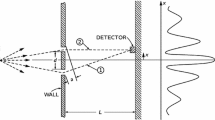Abstract
Complex numbers are basic. An inconsistency would question Wigner’s unreasonable effectiveness of mathematics. A vehicle to study this question is Kirchoff’s scalar diffraction theory. In the paper, an inconsistency in the real phase angle of a complex number is presented. When this inconsistency is introduced in Kirchoff’s theory, we can study its influence on the experimental success of this theory. There are no a priori reasons to include or exclude real phase angles. Referring to Wigner’s idea of the role of mathematics in empirical science, an experiment can provide more insight. In the experiment, a weak intensity, small wavelength source can be employed. When the contradictory phase angle is excluded, a nonzero diffraction amplitude appears physically possible. If it is included, this amplitude vanishes.

Similar content being viewed by others
References
H. Geurdes, Preprints 2021, 2021120079; preprints.org/manuscript/202112.0079.v1, doi: 10.20944; https://vixra.org/abs/2108.0066.
J.W. Goodman, Introduction to Fourier Optics, 2nd edn. (Mc Graw Hill, New York, 1968)
E.W. Marchand, E. Wolf, Consistent formulation of Kirchhoff’s diffraction theory. J. Opt. Soc. Am. 56, 1712–1722 (1966)
J. Saatsi, P. Vickers, Miraculous success? Inconsistency and untruth in Kirchhoff’s diffraction theory. Br. J. Phil. Sci. 62, 29–46 (2011)
J.D. Jackson, Classsical Electrodynamics (Wiley, Hoboken, NJ, 1998)
E. Wigner, The unreasonable effectiveness of mathematics in the natural sciences. Comm. Pure & Appl. Math. 13, 1–14 (1959)
J. Deshpande, Complex Analysis, (McGraw Hill New Dehli 1986), pp. 69-77
A.L. Kovarskii, V.V. Kasparov, A.V. Krivandin et al., EPR spectroscopic and X-ray diffraction studies of carbon fibers with different mechanical properties. Russ. J. Phys. Chem. B 11, 233–241 (2017)
R. Wang, Research on quantitative mechanism of Kirchhoff diffraction acoustical holography. Vibroengineering Proc. 22, 124–128 (2019)
J.B. Keller, Geometrical theory of diffraction. J. Opt. Soc. Am. 52, 116–130 (1962)
W. Lamb, Anti-photon. Apl. Phys. B. 60, 77–84 (1995)
L. Wittgenstein, Philosophical Investigations, transl G.E.M. Anscombe,(third edition, Basil Blackwell, Oxford, UK 1963). Cit:“The results of philosophy are the uncovering of one or another piece of plain nonsense and of bumps that the understanding has got by running its head up against the limits of language...”
Acknowledgements
The author wishes to acknowledge the support of Ad Popper, director Xilion BV.
Author information
Authors and Affiliations
Corresponding author
Ethics declarations
Conflict of interest
The author has no conflict of interest. The author was not funded. There are no data associated.
Additional information
Publisher's Note
Springer Nature remains neutral with regard to jurisdictional claims in published maps and institutional affiliations.
A: Appendix
A: Appendix
Here, the R program is presented to support that

Rights and permissions
About this article
Cite this article
Geurdes, H. Wigner’s effective mathematics and contradiction. J Opt 52, 290–295 (2023). https://doi.org/10.1007/s12596-022-00902-3
Received:
Accepted:
Published:
Issue Date:
DOI: https://doi.org/10.1007/s12596-022-00902-3




